Toward a Human-Centered Digital Ecosystem: NJIT
A Q&A with Ed Wozencroft
Today, digital technology has a place in just about every institution's strategic plan. But at the New Jersey Institute of Technology — a prominent R1 known for its academic programs in fields of advanced technology — the strategic plan looks far beyond the technology, to the human-centered strategies that will build NJIT's unique values into its digital transformation.
NJIT's support for human-centered technology can be seen in its top-level administration: Ed Wozencroft moved from interim Co-CIO to his current role as NJIT's first vice president for digital strategy and chief information officer about a year ago, allowing him to focus much of his time on human-centered strategies for digital transformation. CT talked with Wozencroft about his experience in this role and about NJIT's purposeful steps toward human-centered technology strategies.

NJIT is home to many high-end research technologies. Here, researchers in Chang Yaramothu's vision lab are using visual and neural digital technology to understand brain injury. (Photo courtesy New Jersey Institute of Technology)
Mary Grush: Could you tell us about your goal to build a human-centered digital ecosystem at your institution? What do you mean by human-centered in this context, and why is it an important goal for the New Jersey Institute of Technology?
Ed Wozencroft: To preface, NJIT just released its 2030 strategic plan, "NJIT Makes An Innovation Nexus". And the most exciting part about my job right now, is that deeply embedded in that strategic plan is digital transformation. We call it out as one of our six key priorities, and it's one of two priorities that cut across everything we need to do.
We're a bit unique. NJIT is a highly diverse R1 public polytechnic, so we really put the emphasis on technology, whether it's engineering or any of the sciences. But there's a technology application for everything these days, right? It's hard to avoid any type of computer or system or automation in any field or trade. So, at NJIT we look way beyond the technology in all our strategic planning.
When I talk about human-centered, it's not just a question like, "Can I give you a good laptop?" I can give you IT services, but I'm missing the point if I'm not actually impacting your experience; if I'm not using technology to make your life easier, better, more productive, or simpler in some way so that you can focus more on the value add for whatever you do.
I can give you IT services, but I'm missing the point if I'm not actually impacting your experience; if I'm not using technology to make your life easier, better, more productive, or simpler.
Grush: What are some practical examples?
Wozencroft: If you're a researcher, I want to give you an experience in which you're not tied up with the question of "How do I get the technology to work for me?" Technology needs to work natively so that, for example, if you're doing something with high-performance computing, you don't need to be an expert in HPC. Instead, you can concentrate on being an expert in using HPC for your research purposes.
If you're an HR generalist, you don't want to have to chase down five different screens to figure out the story of an employee you're talking to. You should be able to see the employee data easily, along with any type of information you need to be able to provide a service.
And if you're a student, the days of struggling with the shifting availability of classes should be over, along with any confusion about how to meet requirements for your major. We want to de-mystify the progress toward a degree for students.